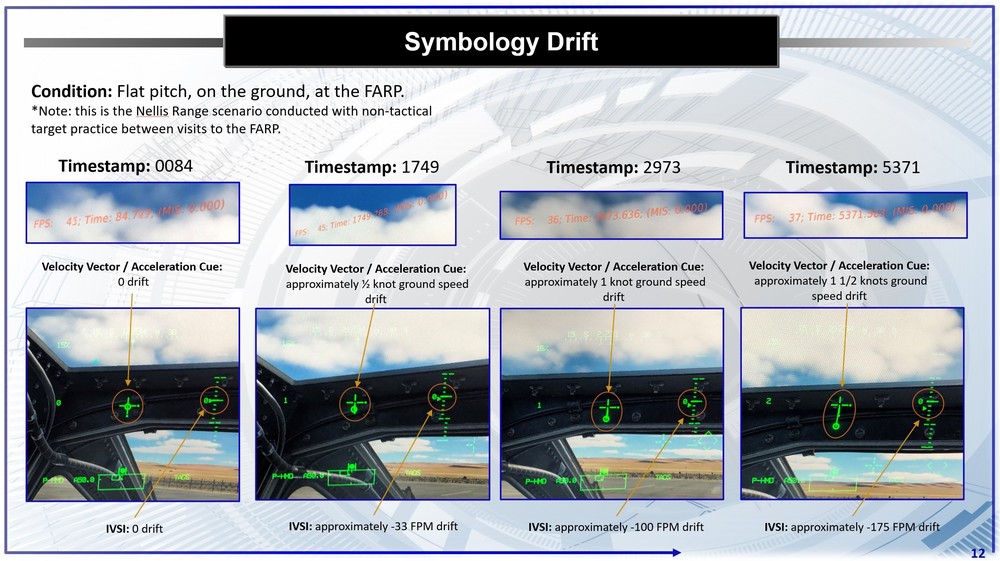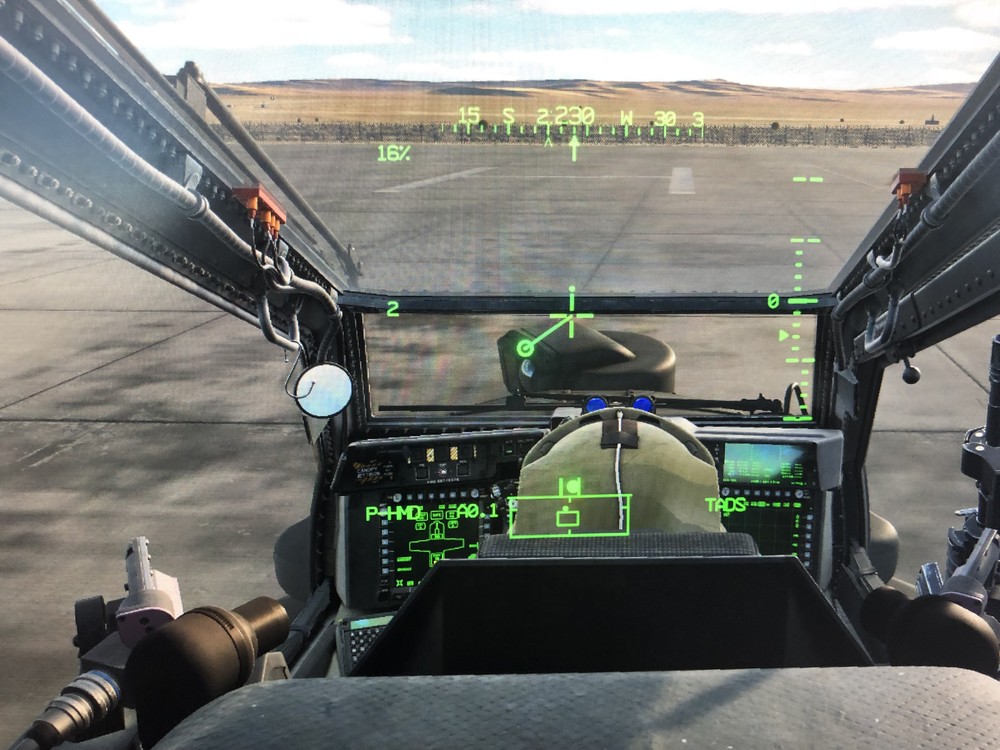-
Posts
36 -
Joined
-
Last visited
-
Mike Force Team started following Talonfox
-
Gents, ISSUE/DISCUSSION: When in flight with rockets selected the HDU will display a rocket steering cursor. Currently it is only displayed if the ARM/SAFE button is in ARM. In SAFE, an inhibited rocket steering cursor is displayed in the actual aircraft but not in the AH-64D module. RECOMMENDATION: Update the module to display an inhibited rocket steering cursor when rockets are WASed but the aircraft is SAFE.
-
•There are 3 TSD map orientation settings: north-up, track-up, and heading-up. •Selecting one of the settings on one MPD’s TSD page automatically transfers the setting to the other MPD’s TSD page in a given crew station. *This was confirmed in the actual aircraft 7 hours ago.
-

reported GPS not arresting INU velocity errors
Talonfox replied to Crptalk's topic in Bugs and Problems
Here is another sequence of symbology drift with associated timestamps. If needed I can DM the 45 MB track file. Best of luck to the troubleshooting team. -

reported Trim with slip indicator always nose left?
Talonfox replied to MstrCmdr's topic in Bugs and Problems
Concur with the aerodynamic modeling requiring constant trim adjustments depending on airspeed. It is a real thing but the problem is not quite solved as the yaw is still in excess of reality. -

reported Cued LOS dot in the Field-Of-Regard box
Talonfox replied to JSpidey's topic in Bugs and Problems
JSpidey is correct that the Cued LOS Dot remains in the field of regard even if the CPG SLAVE button is deactivated. -
ISSUE: The limits of the attitude indicator should be +-90 degrees. DISCUSSION: The limits of the attitude indicator displays "DIVE" on the pitch ladder upon exceeding 30 degrees nose low (see attached track file). The attitude indicator displays 90 degrees pitch nose up and 90 degrees pitch nose down around the lateral axis and 360 degrees around the longitudinal axis. Furthermore, experience from having trained 60 degree dives shows that the ladder itself has lines at -10, -20, -30, -45, and -60 (I'm assuming there is a -90 degree marker from what I've read, but I haven't seen it personally). RECOMMENDATION: Adjust the attitude indicator to include +-45 and +-60 before placing the "DIVE" at +-90. Barometric Altimeter & Pitch Ladder representations.trk
-
ISSUE: The barometric altitude on both the cruise symbology and the flight page show 1 foot increments (see attached track on the climb-out to 2000 MSL). DISCUSSION: The total range of barometric altitude is from -2300 to 20,000 ft, in 10 ft increments. RECOMMENDATION: Adjust the software to reflect 10 ft increments instead. Barometric Altimeter & Pitch Ladder representations.trk
-
The asterisk on the upper right MPD bezel button allows the pilot to toggle through three previously selected "favorite" pages with the single press of the button or by cursor selecting the adjacent digital *. This enables pilots to be able to cycle through critical pages without taking their hands off the controls. REQUEST: Enable this wishlist item when able.
-
ISSUE: Depressing the symbology select button on the cyclic the first time causes the flight page to display on the left MPD. Depressing it a second time does nothing. DISCUSSION: The first press works correctly, the second press should return the left MPD to whatever page was displayed before the flight page. RECOMMENDATION: Update the software to reflect the second press logic. Symbology Select 1 flight page 2 no change.trk
-

cannot reproduce and missing track file Rotor RPM Issues
Talonfox replied to derbarbarian's topic in DCS: AH-64D
In addition, it may be helpful to keep an eye on the torque value in the upper left corner, If you pull more torque than the "governor" allows, you will get a "rotor RPM low" annunciation. On the other hand, I can think of two scenarios which result in "rotor RPM high" : 1. an engine overspeed, and 2. rotor coning which occurs when excessive aft cyclic causes the rotor blades to flex upward and the rotor to spin faster. You can see the physics in action as an ice skater pulls their arms inward during a spin resulting in a velocity increase. Bottom line: Keep an eye on the torque and remember that a helicopter doesn't work the same way as DCS's high performance fixed-wing fighters. Good Hunting -

reported GPS not arresting INU velocity errors
Talonfox replied to Crptalk's topic in Bugs and Problems
I experienced a similar situation last night. After rebooting this morning, the symbology had returned to normal but after a short hour flight it began to drift again. I attached a screenshot of the condition while I was reloading at the FARP. Continuing to collect data on this anomaly. -
ISSUE: TAIL WHL UNLOCK SEL advisory message on the EUFD flickers between 19 & 21% torque (TQ) and is fully extinguished by 22%. DISCUSSION: One source states that when the message is presented the tail wheel unlock position has been selected. (This advisory is only presented when the aircraft is on the ground. In reality, the AH-64D generally ground taxis between 25-30% TQ and as the aircraft gets light around 40-50% the weight-on-wheels switch on the left main landing gear prompts the message to extinguish. Note: the UNLOCK pushbutton illuminates correctly. RECOMMENDATION: Adjust the software to turn off the advisory message at 45% instead of 20%. TAIL WHL UNLOCK SEL EUFD Message extinguishes during ground taxi.trk
- 1 reply
-
- 1
-

-
With Rockets WASed in the pilot station, the “RKT NORM” message is not displayed in the Weapon Status field of the High Action Display prior to an independent rocket engagement. After trigger pull, the “RTOF=NN” is accurately displayed. Also, when the rocket quantity available is 0, a “NO RKTS” message should be presented. No Rocket Norm HAD message .trk
-
Thoroughly enjoying the fidelity of this module! The flight model is superb for a beta release. The accuracy of the symbology is amazing, and the work that went into creating hyper-realistic MPD pages is astounding. Oddly, one thing that is a little off is the sight picture from the pilot station. The sight picture sitting at flat-pitch-ground appears as if no landing gear were installed with the aircraft belly contacting the ground. If the cockpit were raised up 5 feet, the picture would approximate the sight picture of the actual crew station in relation to the ground. Along those same lines, the sight picture at a 5 foot IGE hover appears low, too close to the ground. Conversely, the sight picture at 10 feet is more representative of the actual aircraft at a 5 ft. hover. It is likely that fixing the previous issue would also correct this one. While details like this would be insignificant and easily overlooked by some developers, ED's commitment to excellence and realism, demands that small adjustments like this receive attention. ED, we're all cheering as you knock this one out of the ballpark!





